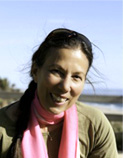Lulled into general ease by our first day, we find our second day that much more excruciating. In fact, in a fit of understatement, I label it the day from hell, a continuous barrage of steep slippery descents into steaming tropical gorges, an occasional tiptoe over a river on a failing plank bridge tied by thick but fraying ropes to stones at either end, followed remorselessly by an arduous, twisting yak trail of a climb up to the next ridge. “Why bother to go down if I just have to go up again,” I grumble to myself in a fit of pique. No encouraging snowy peaks poke over the green hills to lure me onward. A sure sign of Bernard’s soccer folly is his left knee, which starts to ache shortly into our first major descent. By the end of the day he’s hobbling along using his walking poles like crutches to avoid putting wait on his off leg.
At camp that evening I try to ply him with heavy duty anti-inflammatories that I’ve saved from various surgeries. He’s having none of it. It’s as if by taking a pill he’d have to admit something’s wrong. And if he doesn’t take a pill, then he must be fine. To take our mind off our aches, we find a secluded spot where we can dunk naked in the glacial river that rushes by our camp, water that I tell myself must originate somewhere in the vicinity of Kanchenjunga. Bernard’s sole concession to the reality of an injured knee is to dangle his leg in the icy water until the skin is a bright red.
Over the course of two weeks, before we are evacuated by helicopter back to Kathmandu due to Bernard’s increasingly unusable knee, I calculate we walked up and down over 33,000 feet, nearly triple the climb from base camp to the summit of Everest. One afternoon we huddled in a hut of bamboo mats while it poured outside. The young mother living there carefully scooped warm water from a small pot that heated by a spluttering fire, drizzled it over her baby boy, tenderly soaped him with a bar of green and white Irish Spring, rinsed him off with another handful, swaddled him in a purple shawl and sat him six inches from those same flames. She shared her roasted potatoes with us. We presented her with a plate heaped with all the curries and savories our cook prepared for us for lunch that day. And despite the somewhat baleful glares of the camp staff, who saw their usual portion of leftover food dwindle as a result, I’m glad we did.
As we trekked higher, rhododendrons dropped their luscious magenta and lavender blossoms on the trail, mountain streams changed from trickles to gushing cascades, and Tibetan refugees appeared, hoping for donations to their village assistance funds. We gave. The way was rugged, perfect for yak, less than ideal for humans. Every step had to be calculated and placed just so. Every once in awhile I could catch a glimpse of a monolithic white peak of staggering dimensions, which would then disappear behind the next ravine or ridge. When the towering white face of Jannu finally appeared, its broad shoulders flanking a central peak, I gasped in amazement. It is one thing to live beneath the snowy peaks of the Rockies and to find them lovely, as I do. Here I was in the august presence of peaks so high that even the small ones break 20,000 feet. It’s the difference between enjoying the company at the local diner and dining with the Queen.
Occasionally I’d lift my eyes from the trail, hoping to spot a blue sheep or a snow leopard. It’s possible they were there. I never saw them, but then neither did I twist a knee by not watching where I was going. One thing made me immensely happy: we passed only ten foreigners on the way to Kanchenjunga base camp, and seeing a white face was such a surprise that I actually didn’t resent them.










